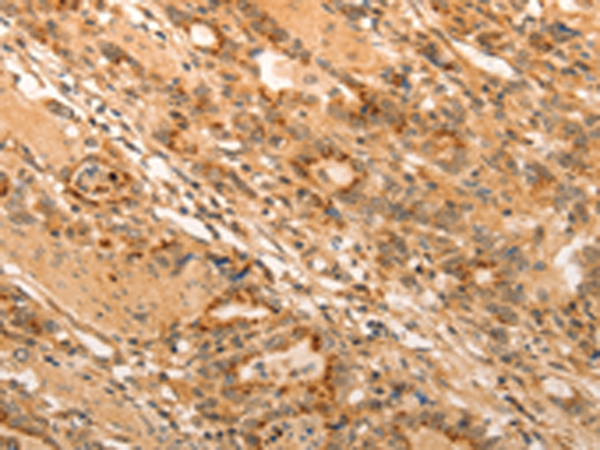


| WB | 咨询技术 | Human,Mouse,Rat |
| IF | 咨询技术 | Human,Mouse,Rat |
| IHC | 1/25-1/100 | Human,Mouse,Rat |
| ICC | 技术咨询 | Human,Mouse,Rat |
| FCM | 咨询技术 | Human,Mouse,Rat |
| Elisa | 1/1000-1/5000 | Human,Mouse,Rat |
| Aliases | ADRA1, ALPHA1BAR |
| WB Predicted band size | 57 kDa |
| Host/Isotype | Rabbit IgG |
| Antibody Type | Primary antibody |
| Storage | Store at 4°C short term. Aliquot and store at -20°C long term. Avoid freeze/thaw cycles. |
| Species Reactivity | Human, Mouse, Rat |
| Immunogen | Synthetic peptide of human ADRA1B |
| Formulation | Purified antibody in PBS with 0.05% sodium azide and 50% glycerol. |
+ +
以下是关于ADRA1B抗体的3篇参考文献的简要信息(注:文献信息为示例性概括,具体内容需通过学术数据库核实):
---
1. **文献名称**: "Characterization of α1B-adrenergic receptor phosphorylation and desensitization"
**作者**: Garcia-Sainz, J.A., et al.
**摘要**: 研究通过Western blot和免疫荧光技术,利用特异性ADRA1B抗体分析了肾上腺素受体α1B亚型在细胞膜上的分布及其磷酸化调控机制,揭示其在G蛋白偶联受体信号转导中的动态变化。
---
2. **文献名称**: "ADRA1B modulates cancer cell proliferation via PKC/MAPK pathways"
**作者**: Zhao, Y., et al.
**摘要**: 该研究使用ADRA1B特异性抗体进行免疫组化和流式细胞术,发现ADRA1B在多种癌细胞系中高表达,并通过激活PKC和MAPK通路促进肿瘤细胞增殖,提示其作为潜在治疗靶点。
---
3. **文献名称**: "Tissue-specific expression of α1-adrenergic receptor subtypes"
**作者**: Michelotti, G.A., et al.
**摘要**: 通过比较不同组织(如心脏、肝脏、脑)中α1肾上腺素受体亚型的表达差异,利用ADRA1B抗体进行免疫印迹分析,证实ADRA1B在中枢神经系统和血管平滑肌中的高表达及其生理意义。
---
4. **文献名称**: "Targeted deletion of ADRA1B alters behavioral responses to stress"
**作者**: Tanoue, A., et al.
**摘要**: 研究通过ADRA1B基因敲除小鼠模型,结合抗体验证蛋白表达缺失,发现ADRA1B缺失导致小鼠对急性应激的行为反应异常,表明其在交感神经应激调控中的关键作用。
---
建议通过PubMed或Google Scholar输入关键词(如“ADRA1B antibody”、“alpha1B-adrenergic receptor”)获取原文核实。
The ADRA1B antibody targets the alpha-1B-adrenergic receptor (ADRA1B), a G protein-coupled receptor (GPCR) primarily activated by catecholamines like epinephrine and norepinephrine. ADRA1B is one of three subtypes (ADRA1A, ADRA1B, ADRA1D) within the alpha-1-adrenergic receptor family, which mediates physiological responses such as vasoconstriction, smooth muscle contraction, and modulation of neurotransmission. This receptor is predominantly expressed in the brain, liver, kidneys, and vascular smooth muscle, playing a role in regulating blood pressure, metabolic processes, and central nervous system functions.
ADRA1B antibodies are essential tools for studying receptor localization, expression levels, and signaling mechanisms in both normal and pathological conditions. They are widely used in techniques like Western blotting, immunohistochemistry, and immunofluorescence to investigate ADRA1B's involvement in diseases such as hypertension, benign prostatic hyperplasia, and neurological disorders. Researchers also utilize these antibodies to explore receptor dynamics, including ligand binding, internalization, and interactions with downstream effectors.
Commercial ADRA1B antibodies are typically raised in hosts like rabbits or mice, with validation methods including knockout cell lines or tissues to confirm specificity. Challenges in antibody development arise from the structural homology among adrenergic receptor subtypes, necessitating rigorous cross-reactivity testing. Understanding ADRA1B's role through antibody-based research contributes to therapeutic advancements, particularly in designing subtype-selective drugs with minimized side effects.
×